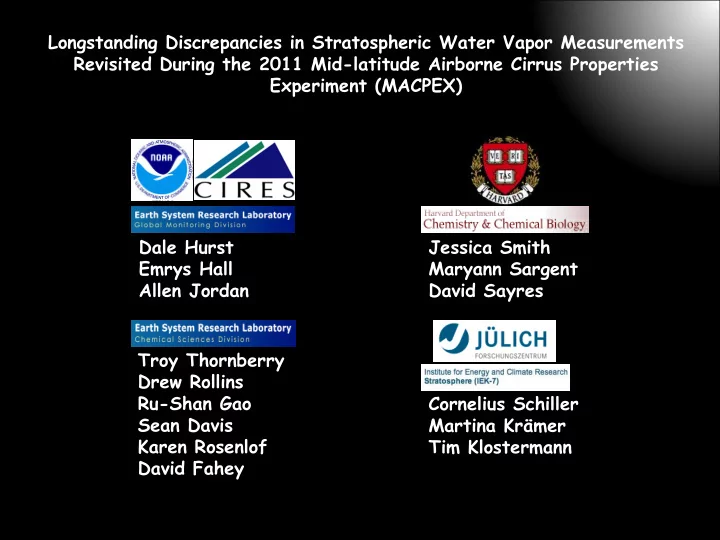

Longstanding Discrepancies in Stratospheric Water Vapor Measurements Revisited During the 2011 Mid-latitude Airborne Cirrus Properties Experiment (MACPEX) Dale Hurst Jessica Smith Emrys Hall Maryann Sargent Allen Jordan David Sayres Troy Thornberry Drew Rollins Ru-Shan Gao Cornelius Schiller Sean Davis Martina Krämer Karen Rosenlof Tim Klostermann David Fahey
Stratospheric water vapor differences – one historical view These differences are: Fairly consistent with altitude during each flight Quite variable from one flight/campaign to the next Typically 15-60% of the water vapor mixing ratio Courtesy of Holger Vömel
Why are water vapor measurement differences a concern? • Disparities of this magnitude infer sizeable uncertainties in water vapor measurements (inaccuracy) • Biases that vary with time add significant uncertainties to long-term water vapor trends The Boulder Frost Point Hygrometer Record • Trend uncertainties propagate into estimates of RF - Boulder WV increase (1980-2000) enhanced RF by 30% - Hurst et al . [2011] Solomon et al . [2010]
Differences Also Exist Between Satellite-Borne Sensors MLS – HALOE ≈ 0.5 ppmv during 16-month operational overlap Good agreement between MLS and FPH suggests HALOE adjustment Adjusted HALOE: +0.5 ppmv (Davis and Rosenlof)
Frost Point – Satellite • HALOE (adjusted) • MLS Boulder Overpasses No statistical biases Significant trends: FP-HALOE: 18-100 hPa FP-MLS: none Lauder Overpasses No statistical biases No significant trends (MLS only)
Right Superpod (with Left Spear Pod spear pod forebody) Harvard Water Vapor 2DS (includes HHH) CPI SID3 FCDP Right Spear Pod HVPS ALIAS CIN CLH Ideally … DLH Mirror Left Hatches VIPS JLH Left Superpod Harvard Halogen Right Hatches Nose ULH PALMS DLH MMS DLH Retroreflector Payload Bay: Forward transition – MMS electronics, O3 Pallet 1 (P305) – Harvard Total Water Pallet 2 (P301) – FCAS, NMASS Pallet 3 (P306) – CIMS, SP2, O3Lite Pallet 4 (P303) – FISH � As of 24 Mar 11
Aircraft Instrument Comparisons
Aircraft Instrument Differences – Summary Statistics 0.5 ± 0.2 ppmv -0.3 ± 0.2 ppmv (N=78) (N=63)
Right Superpod (with Left Spear Pod spear pod forebody) Harvard Water Vapor 2DS (includes HHH) CPI SID3 FCDP Right Spear Pod HVPS ALIAS CIN CLH Ideally … DLH Mirror Left Hatches VIPS JLH Left Superpod Harvard Halogen NOAA FPH or CFH Right Hatches Nose ULH PALMS DLH MMS DLH Retroreflector Payload Bay: Forward transition – MMS electronics, O3 Pallet 1 (P305) – Harvard Total Water Pallet 2 (P301) – FCAS, NMASS Pallet 3 (P306) – CIMS, SP2, O3Lite Pallet 4 (P303) – FISH � As of 24 Mar 11
Balloon vs Aircraft Instrument Comparisons
A/C Instrument - Frost Point Differences: Summary Stats 0.0±0.2 ppmv 0.4±0.1 ppmv 0.7±0.2 ppmv (N=58) (N=43) (N=59)
Conclusions Since 1993: campaign-dependent biases of 15-60% between Harvard Lyman- and NOAA Frost Point Hygrometers Biases between HALOE & MLS/FPH in 2004-05 suggest HALOE adjustment • FP-adjusted HALOE: significant trends at 18-100 hPa (1991-2005) • FP-MLS: No biases or trends (2004-2012) MACPEX: statistically significant biases between 3 aircraft instruments HW-FISH (0.5±0.2 ppmv) & HW-CIMS (-0.3±0.2 ppmv) MACPEX: no statistically significant bias between FP and FISH (0.0±0.2 ppmv) MACPEX: statistically significant biases between FP and HW and CIMS HW-FP (0.4±0.1 ppmv) & CIMS-FP (0.7±0.2 ppmv) (these are consistent with the biases between aircraft instruments) Biases revealed during MACPEX are smaller than most historical differences between HW and the Frost Point Hygrometers This indicates progress in eliminating water vapor measurement biases but further efforts are clearly necessary
Thank you for your attention
Aircraft – Balloon Coincidences
Recommend
More recommend